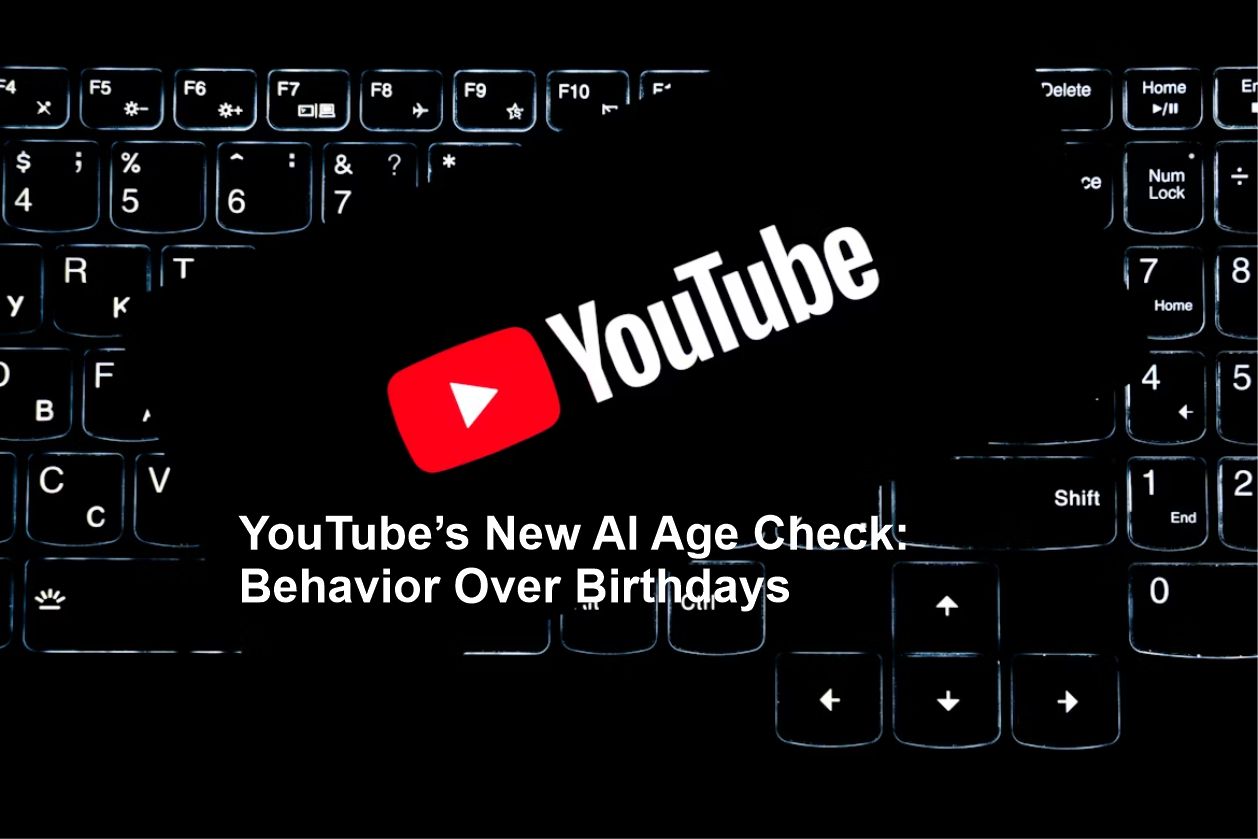From Birthdays to Behaviour: How AI is Redefining Age Verification Online
For years, YouTube has relied on a simple method to determine whether a user was a child, teenager, or adult: the date of birth typed into the sign-up form. If you claimed you were 18 or older, the system generally took your word for it. The flaw in this approach was obvious—anyone could lie about their age in a few seconds.
Today, that system is being disrupted. YouTube, one of the most influential platforms on the internet, is rolling out a more sophisticated and arguably more intrusive way of determining age. Instead of depending solely on what you declare at sign-up, the platform will now analyze your behavior, watch history, and interaction patterns to estimate whether you are under 18.
This experiment, already being tested in the United States, could reshape the viewing experience for millions of users, impact content creators’ revenue, and set a precedent for how digital platforms worldwide handle age verification.
Why the Change? The Flaws of Birthday-Based Verification
Online platforms have always faced a tricky balancing act: protecting children from harmful or age-inappropriate content while maintaining accessibility and user freedom.
Traditionally, platforms like YouTube asked for a date of birth during registration. But this system had two huge weaknesses:
- Easily Manipulated – Kids quickly learned that all they had to do was type a fake year of birth to gain access to restricted content.
- No Continuous Checks – Once you claimed to be 18 at sign-up, the platform rarely questioned it again.
Regulators and child safety advocates criticized these loopholes, pushing platforms to adopt more reliable age-gating methods. That pressure has now led YouTube to adopt AI-driven age estimation models, which focus less on what you “say” and more on what you “do.”
How YouTube’s AI Age Estimation Works
The new system relies on machine learning algorithms trained to identify patterns of behavior that suggest whether a user is under 18. Instead of looking at a single data point (your date of birth), it evaluates multiple signals, including:
- Viewing History – What kind of videos you watch plays a huge role. Someone who primarily consumes cartoons, animated series, or school-related educational videos may be flagged as a likely teenager.
- Engagement Behavior – Teens and adults tend to comment, like, and share content differently. For example, teenagers might engage more frequently with memes, trends, or short-form content like YouTube Shorts.
- Session Length & Timing – Teens often watch in bursts after school hours or late at night, while adults may have steadier viewing habits.
- Account Longevity – A brand-new account with little history is more suspicious and more likely to be classified cautiously.
If the system estimates you’re under 18, teen protection settings are automatically enabled—even if you previously claimed to be older.
What Happens if You’re Classified as a Teen?
Once flagged, YouTube will shift your account into its teen protection mode. This is designed to create a safer, more responsible online environment for younger users. The changes include:
- Non-Personalised Ads Only
- Targeted ads disappear. Teens will see generic, broad ads rather than ones based on their browsing history.
- This means reduced ad tracking and greater privacy.
- Digital Wellbeing Tools by Default
- Features like “Take a Break” reminders and bedtime prompts are automatically enabled.
- These tools are intended to help regulate screen time and prevent excessive binge-watching.
- Privacy Nudges
- Teens receive reminders to think before commenting publicly or uploading personal content.
- Uploading visibility defaults to private unless changed.
- Stronger Content Moderation
- Recommendations for potentially harmful content, such as extreme dieting or repetitive sensational videos, are minimized.
- Graphic or explicit videos are automatically age-restricted.
- Blocked Age-Restricted Content
- If a video is rated 18+, teens won’t be able to watch it unless they verify their age with official documents.
How Teens Can Verify Their Age
If you believe the system has misclassified you, YouTube offers three ways to prove your age:
- Government-Issued ID – Upload a valid ID card or passport for manual verification.
- Selfie Verification – Take a live selfie to compare against your ID or biometric data.
- Credit Card Validation – Use a credit card to confirm adult status (only for verification, not payment).
These options ensure that older teens or mistakenly flagged adults can regain access to unrestricted content.
Why This Matters: The Big Picture
At first glance, this change may seem minor—just another technical tweak. But in reality, it signals a fundamental shift in online identity verification.
- For Users: Even if you said you were 18 years old when signing up, your current behavior might now classify you as a teen. This impacts your recommendations, ads, and overall platform experience.
- For Parents & Regulators: This shows YouTube’s commitment to stricter compliance with global child protection laws, especially in the U.S. and EU.
- For Creators: Since teen accounts only receive non-personalised ads, creators could see reduced revenue if their audience skews younger.
Impact on Creators and Monetization
Creators form the backbone of YouTube’s ecosystem, and this shift will inevitably ripple through their revenue streams. Here’s how:
- Smaller Ad Revenue
- Non-personalised ads generally pay less than targeted ads.
- More viewers classified as teens = reduced CPM (cost per thousand impressions) rates for creators.
- Changed Audience Metrics
- Audience analytics may suddenly show a larger under-18 demographic.
- This can alter sponsorship deals and brand collaborations, since advertisers often prefer adult audiences.
- Limited Visibility for Certain Content
- Creators covering borderline topics—like fitness, gaming violence, or mature themes—may find their content restricted from teen recommendations.
YouTube admits the impact but insists most creators won’t be severely affected:
“Some creators may experience a shift in their audience categorized as teens (under 18). This may result in a decrease in ad revenue since we only serve non-personalised ads to those viewers. We estimate this will have limited impact for most creators.”
Still, for niche channels that cater heavily to teenagers—such as gaming, lifestyle, or pop culture creators—the change could be significant.
The Regulatory Push Behind the Shift
This isn’t happening in a vacuum. Global regulators have been pressuring tech companies to do more to protect minors online.
- United States: The Children’s Online Privacy Protection Act (COPPA) requires platforms to safeguard users under 13. Growing concern about teen mental health has pushed regulators to demand broader protections for under-18 users as well.
- European Union: The Digital Services Act (DSA) enforces stricter rules around protecting minors, requiring platforms to minimize harmful content exposure.
- Global Trend: Countries like the UK, Australia, and India are also drafting or enforcing child safety regulations that demand stricter age verification.
By moving toward AI-driven age estimation, YouTube is proactively adapting before facing harsher penalties.
The Benefits and Concerns of AI-Based Age Estimation
Like any new system, YouTube’s approach has both advantages and controversies.
Benefits
- More reliable than self-declared birthdays.
- Protects minors from harmful or inappropriate content.
- Reduces targeted advertising toward teenagers, improving privacy.
- Helps YouTube comply with international safety regulations.
Concerns
- Privacy: Critics worry about the extent of behavioral data being analyzed.
- Accuracy: What if an adult who enjoys cartoons or anime gets wrongly classified as a teen?
- Revenue Loss for Creators: Channels that rely on teen audiences may see reduced monetization.
- User Experience: Some may feel unfairly restricted or frustrated by constant verification requests.
Is This the Future of Online Identity?
YouTube’s experiment could set a precedent for other platforms. If successful, we may soon see AI-driven age estimation applied across:
- Social Media (Instagram, TikTok, Snapchat)
- Streaming Services (Netflix, Disney+)
- Gaming Platforms (Xbox Live, PlayStation Network)
- E-Commerce (age-restricted purchases online)
Instead of trusting what users say, digital platforms may increasingly rely on behavioral analysis to decide who we are.
What Users Should Do
As this system rolls out, here’s how you can prepare:
- Understand Your Classification – If you suddenly see fewer personalised ads or restricted content, it may be because YouTube flagged your account as under 18.
- Verify Your Age If Needed – Keep an ID or credit card handy if you want unrestricted access.
- Parents Should Stay Informed – This system gives parents more assurance that teens are protected, but it’s still worth monitoring kids’ activity.
- Creators Should Adapt – If your channel caters to teens, consider diversifying content to attract adult audiences and balance revenue loss.
Final Thoughts: The Age You Feel vs. The Age YouTube Thinks You Are
YouTube’s new AI-powered age estimation system is more than just a technical tweak. It’s a paradigm shift in how platforms define identity online. No longer can users simply declare themselves 18 or older—now their habits, preferences, and interactions will shape how the platform treats them.
For teens, this means greater safety, privacy, and healthier digital habits. For creators, it could mean lower ad revenue and shifting audience metrics. And for everyday users, it’s a reminder that in the digital age, algorithms increasingly decide who we are.
As this system expands globally, both viewers and creators will need to adapt—because the age you feel might not be the age YouTube thinks you are.

